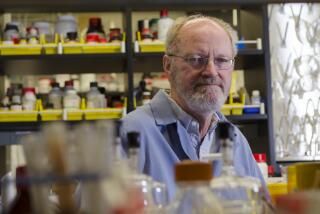Geoffrey Burbidge dies at 84; astrophysicist co-discovered how elements are synthesized in stars
Astrophysicist Geoffrey Burbidge, who with his wife and two other colleagues determined how elements are synthesized in the nuclear reactors of stars, died Tuesday at Scripps Memorial Hospital in La Jolla after a long illness. He was 84.
Widely honored for his contributions to astrophysics, cosmology and the study of radio galaxies, Burbidge became notorious in recent years for his refusal to accept the widely held view that the universe originated in a Big Bang, arguing instead that matter is continually created, emerging as quasars ejected from energetic galaxies.
But the English-born scientistâs place in posterity is preserved by his work determining how all the heavy elements in the universe can be synthesized from the simple hydrogen atom in the intense fusion furnaces of stars.
Over a period of 18 months spent scribbling on blackboards in a windowless room at Caltech, Burbidge; his wife, Margaret; American physicist William Fowler; and British astronomer Sir Fred Hoyle overcame the roadblocks that had beset other theoreticians and provided a clear pathway to each of the elements.
Their 104-page 1957 paper in the Reviews of Modern Physics âwas without question one of the most important papers of all time in astrophysics,â said Mark Thiemens, dean of the division of physical sciences at UC San Diego, where the Burbidges spent most of their careers.
Astrophysicist George Fuller, director of UC San Diegoâs Center for Astrophysics and Space Sciences, said, âThis paper laid the foundation for an entirely new kind of synthesis of astronomical observations with frontier nuclear and particle science, paving the way for much of modern astrophysics and cosmology.â
Two years later, Geoffrey, then 34, and Margaret, 40, received the American Astronomical Societyâs highest prize for young astronomers. In 1983, Fowler received the Nobel Prize in physics for his role in the collaboration.
Many of their colleagues believed that the Burbidges and Hoyle were excluded from the award because of their failure to bow to the prevailing influence of the Big Bang theory. Burbidge, however, never publicly expressed bitterness about his exclusion.
He later spent considerable time studying radio galaxies and was the first to determine the enormous amounts of energy involved in the radio emissions. His studies ultimately led astrophysicists to consider gravity as the energy source for these objects, as well as for quasi-stellar objects, or quasars.
âMuch of the Burbidgesâ work revolved around the nature of quasars and active galactic nuclei,â said astrophysicist Art Wolfe, a former director of the astrophysics center at UC San Diego. âDuring the 1960s, the Burbidges were virtually alone in their efforts to measure the masses of galaxies from the rotation speeds.â Geoffrey Burbidgeâs penetrating ideas and questions stimulated much research by others, even though his ideas were not always confirmed.
Quasars ultimately proved to be the cause of his isolation from other cosmologists. Quasars, extremely bright objects, have a very high red shift -- a displacement in their spectra -- that is believed by Big Bang theorists to mean that they are exceptionally distant from the Earth. Burbidge and Hoyle, however, argued that the quasars are emitted from relatively nearby galaxies at relativistic speeds, which accounts for their red shift.
The scientists believed that the quasars are created in these energetic galaxies and that they are the source of new matter in the universe, keeping it at a relatively steady state of mass as other matter is lost in energy-producing reactions. Their view was largely abandoned, however, after the 1964 discovery of the cosmic microwave background radiation, widely believed to be a remnant of the Big Bang.
The Burbidges spent recent years identifying quasars that they believed were relatively nearby and supported their point of view, but other astronomers seemed to be paying little attention.
Hoyle died in 2001. With Burbidgeâs death, there remain few strong proponents of this view.
Geoffrey Burbidge was born Sept. 24, 1925, in Chipping Norton, England, the son of a builder. His primary interests were math and history, and he intended to study history at the University of Bristol. With World War II and his familyâs precarious finances, however, he decided to study physics because he could get financial support. He earned his bachelorâs degree in 1946 and his doctorate in physics at University College London in 1951.
He had no interest in astronomy, he said, but in a graduate seminar met astronomer Margaret Peachy. They were married in 1948 âand that is how I got into astronomy,â he often said. The couple had been together ever since, making stops at a variety of institutions before settling at UC San Diego in 1962. He was director of the Kitt Peak National Observatory in Arizona from 1978 to 1984.
He also was editor-in-chief of the Annual Review of Astronomy and Astrophysics for 30 years and scientific editor of the Astrophysical Journal for many years. Even after his formal retirement from UC San Diego in 2002, Burbidge and his wife went to their office every day to continue their research and writing.
In addition to his wife, Burbidge is survived by a daughter, Sarah, of San Francisco; and a grandson, Connor Loeven.




